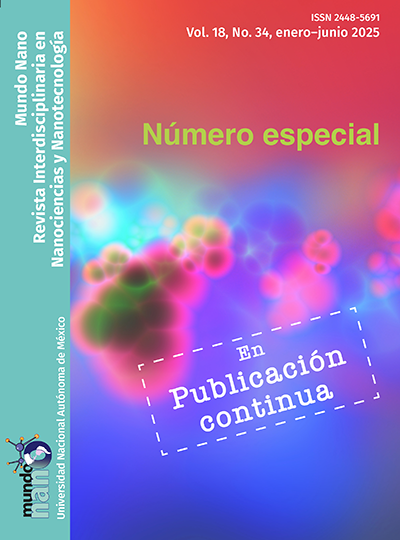Heavy metal removal in water using magnetic bioadsorbents
Main Article Content
Abstract
In this study, synthesis, characterization, and application of a pectin - magnetite bioadsorbent with magnetic properties for heavy metal removal in aqueous solutions were carried out. Pectin was obtained from Aloe Vera leaves whereas magnetite nanoparticles were incorporated through coprecipitation method. The material was characterized via FTIR, XRD, and SEM techniques. The maximum adsorption capacity for Lead (II) and Chromium (VI) ions was estimated through adsorption isotherms, resulting in 36,442 mg Pb/g and 2,254 mg Cr/g. This indicates a higher affinity from the bioadsorbent toward Lead (II). The removal of Lead (II) was also evaluated in a packed bed adsorber, both with fresh bed, and reused bed under an external magnetic field; adsorption capacities of 9,6 mg/g and 5,3 mg/g were obtained, respectively. The magnetic properties of the material allowed for modifications in the evaluated schemes, proposing new arrangements and comparing their efficiency in terms of adsorption capacity and dimensions. The most efficient schemes were the packed column and the coated tube (WCOT), where the adsorbent was annularly disposed on a coated wall.
Downloads
Article Details

Mundo Nano. Revista Interdisciplinaria en Nanociencias y Nanotecnología por Universidad Nacional Autónoma de México se distribuye bajo una Licencia Creative Commons Atribución-NoComercial 4.0 Internacional.
Basada en una obra en http://www.mundonano.unam.mx.
References
Benítez, R., S. Pabón, R. Sarria-Villa y J. Gallo. (2020). Contaminación del agua por metales pesados, métodos de análisis y tecnologías de remoción: una revisión. Entre ciencia e ingeniería. Scielo-EPub, 14(27): 9-18. https://doi.org/10.31908/19098367.0001. DOI: https://doi.org/10.31908/19098367.1734
Bilal, M., I. Ihsanullah, M. Younas y M. Hassan. (2021). Recent advances in applications of low-cost adsorbents for the removal of heavy metals from water: a critical review. Separation and Purification Technology, 278. https://doi.org/10.1016/j.seppur.2021.119510. DOI: https://doi.org/10.1016/j.seppur.2021.119510
Brown, P., S. Grill y S. Allen. (2000). Metal removal from wastewater using peat. Water Research, 34(16): 3907-3916. http://dx.doi.org/10.1016/S0043-1354(00)00152-4. DOI: https://doi.org/10.1016/S0043-1354(00)00152-4
Cai, D., T. Zhang y X. Luo. (2017). Quaternary ammonium β-cyclodextrin-conjugated magnetic nanoparticles as nano-adsorbents for the treatment of dyeing wastewater: synthesis and adsorption studies. Journal of Environmental Chemical Engineering, 5(3): 2869-2878. https://doi.org/10.1016/j.jece.2017.06.001. DOI: https://doi.org/10.1016/j.jece.2017.06.001
Caviedes, D. I., R. R. Muñoz, A. Perdomo, D. Rodríguez y L. J. Sandoval. (2015). Tratamientos para la remoción de metales pesados comúnmente presentes en aguas residuales industriales. Una revisión. Ingeniería y Región, (13): 73-90. https://doi.org/10.25054/22161325.710. DOI: https://doi.org/10.25054/22161325.710
Chang, Y. C. y D. H. Chen. (2005). Preparation and adsorption properties of monodisperse chitosan-bound Fe3O4 magnetic nanoparticles for removal of Cu(II) ions. Journal of Colloid and Interface Science, 283(2): 446-451. https://doi.org/10.1016/j.jcis.2004.09.010. DOI: https://doi.org/10.1016/j.jcis.2004.09.010
Chen, X., M. Faysal, D. Chengyu, J. Lu, Y. Fai, M Shoffikul y Y. Zhou. (2022). Isotherm models for adsorption of heavy metals from water – A review. Chemosphere, 307(1). https://doi.org/10.1016/j.chemosphere.2022.135545. DOI: https://doi.org/10.1016/j.chemosphere.2022.135545
De León, J., V. Reyes, E. Hernández, S. Pérez, L. Hurtado y B. Landeros. (2019). Synthesis and characterization of magnetite nanoparticles for photocatalysis of nitrobenzene. Journal of Saudi Chemical Society, 24(2): 223-235. King Saud University. https://doi.org/10.1016/j.jscs.2019.12.004. DOI: https://doi.org/10.1016/j.jscs.2019.12.004
El-Dib, F., D. Mohamed, O. El-Shamy y M. Mishrif. (2020). Study the adsorption properties of magnetite nanoparticles in the presence of different synthesized surfactants for heavy metal ions removal. Egyptian Journal of Petroleum, 29: 1-7. https://doi.org/10.1016/j.ejpe.2019.08.004. DOI: https://doi.org/10.1016/j.ejpe.2019.08.004
Femenia, A., E. Sánchez, S. Simal y C. Roselló. (2017). Compositional features of polysaccharides from Aloe vera (Aloe Barbadensis Miller) plant tissues. Carbohydrate Polymers, 39(2): 109-117. https://doi.org/10.1016/S0144-8617(98)00163-5. DOI: https://doi.org/10.1016/S0144-8617(98)00163-5
Foba-Tendo, J., J. Namanga, N. Yufanyi y W. Krause. (2013). A one pot green synthesis and characterisation of iron oxide-pectine hybrid nanocomposites. Open Journal of Composite Material, 3: 30-37. https://doi.org/10.4236/OJCM.2013.32005. DOI: https://doi.org/10.4236/ojcm.2013.32005
García, C., J. Moreno, M. Hernández y A. Polo. (2002). Metales pesados y sus implicaciones en la calidad del suelo. Ciencia y Medio Ambiente, 125-138.
García, V., A. Yipmantin, E. Guzmán, R. Pumachaga y H. Maldonado. (2011). Estudio de la cinética de biosorción de iones plomo en pectina reticulada proveniente de cáscaras de cítricos. Revista de la Sociedad Química del Perú, 77(3): 173-181.
Giraldo, L., A. Erto y J. Moreno. (2013). Magnetite nanoparticles for removal of heavy metals from aqueous solutions: synthesis and characterization. Adsorption, 19: 465-474. https://doi.org/10.1007/s10450-012-9468-1. DOI: https://doi.org/10.1007/s10450-012-9468-1
Guerra, J. y A. Portillo. (2018). Estudio de las propiedades del sistema magnetita-pectina como adsorbente de metales en agua. Jornadas de investigación, Facultad de Ingienieria, Universidad Central de Venezuela.
Jixiang, L., B. Jiang, Y. Liu, C. Qiu, H. Jiajun, G. Qian, W. Gou y H. Nao Ngo. (2017). Preparation and adsorption properties of magnetic chitosan composite adsorbent for Cu2+ removal. Journal of Cleaner Production, 158: 51-58. https://doi.org/10.1016/j.jclepro.2017.04.156. DOI: https://doi.org/10.1016/j.jclepro.2017.04.156
Lu, An-Hui, E. L. Salabas y Ferdi Schuth. (2007). Magnetic nanoparticles: synthesis, protection, functionalization, and application. Angewandte Chemie (International ed. in English), 46(8): 1222-1244. https://doi.org/10.1002/anie.200602866. DOI: https://doi.org/10.1002/anie.200602866
Matmin, J., I. Affendi, S. Ilyana y S. Endud. (2018). Additive free rice starch-assisted synthesis of spherical nanostructured hematite for degradation of dye contaminant. Nanomaterials, 8(9). https://doi.org/10.3390/nano8090702. DOI: https://doi.org/10.3390/nano8090702
Meza-Gaspar, T., R. Castillo-Zamudio, H. Váquiro-Herrera, I. Paniagua-Martínez, C. Ozuna y E. Corona-Jiménez. (2017). Obtención de pectina de guayaba (Psidium Guajava L.Var. Media China) mediante hidrólisis ácida asistida con ultrasonido de alta intensidad. Investigación y Desarrollo en Ciencia y Tecnología de Alimentos, 2: 575-581.
Rojas, Y. y C. Zarate. (2015). Efecto del pH y el tiempo de contacto en la adsorción de cromo hexavalente en solución acuosa utilizando montmorillonita como adsorbente. Repositorio Institucional de la UNCP. https://repositorio.uncp.edu.pe/handle/20.500.12894/1012.
Solomon, O., K. Adesina, A. Abiola y H. Abdualazeez. (2013). Dye adsorption using biomass wastes and natural adsorbents. Desalination and Water Treatment, 53(5): 1-29. http://dx.doi.org/10.1080/19443994.2013.862028. DOI: https://doi.org/10.1080/19443994.2013.862028
Toma, H. (2015). Magnetic nanohydrometallurgy: a nanotechnological approach to elemental sustainability. Green Chem., 17: 2027-2041. https://doi.org/10.1039/C5GC00066A. DOI: https://doi.org/10.1039/C5GC00066A
Valencia, J. y C. Castellar. (2013). Predicción de las curvas de ruptura para la remoción de plomo (II) en disolución acuosa sobre carbón activado en una columna empacada. Revista de la Facultad de Ingeniería de la Universidad de Antioquia, 66: 141-158.
Vera, M., D. Bermejo, M. Uguña, N. García, M. Flores y D. Brazales. (2018). Modelado de columna de lecho fijo para la bioadsorción de Cd+2 y Pb+2 con cáscaro de cacao. Revista Internacional de Contaminación Ambiental, 4(34): 611-620. https://doi.org/10.20937/RICA.2018.34.04.05. DOI: https://doi.org/10.20937/RICA.2018.34.04.05
Zhao, J., R. Boada, G. Cibin y C. Palet. (2021). Enhancement of selective adsorption of Cr species via modification of pine biomass. Science of The Total Environment, 756. https://doi.org/10.1016/j.scitotenv.2020.143816. DOI: https://doi.org/10.1016/j.scitotenv.2020.143816





